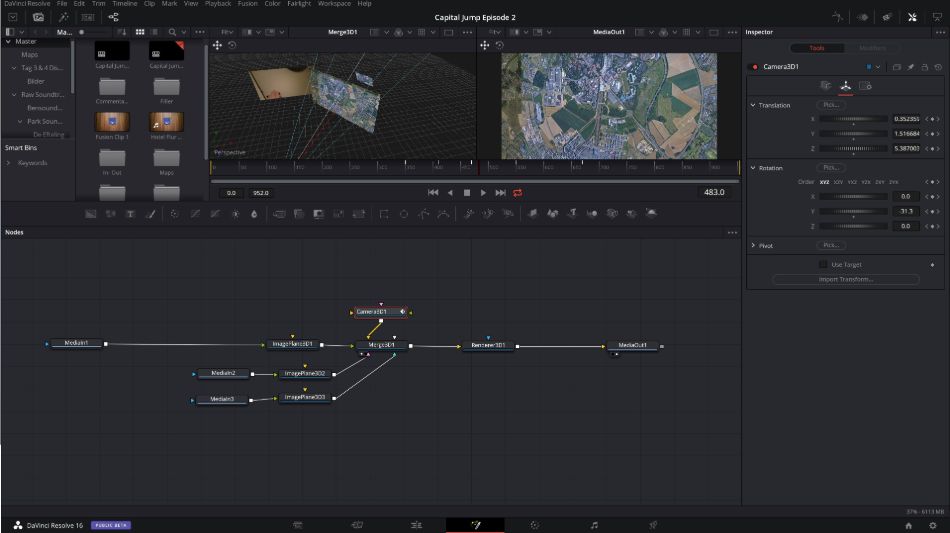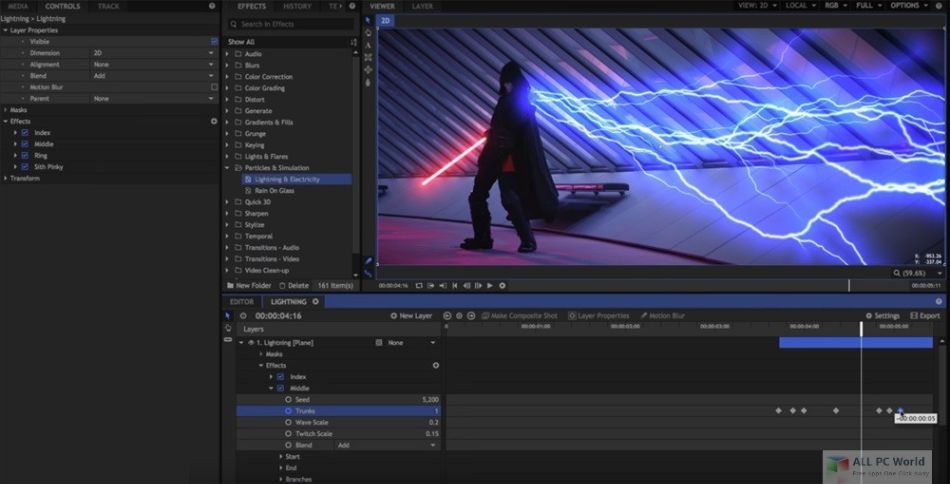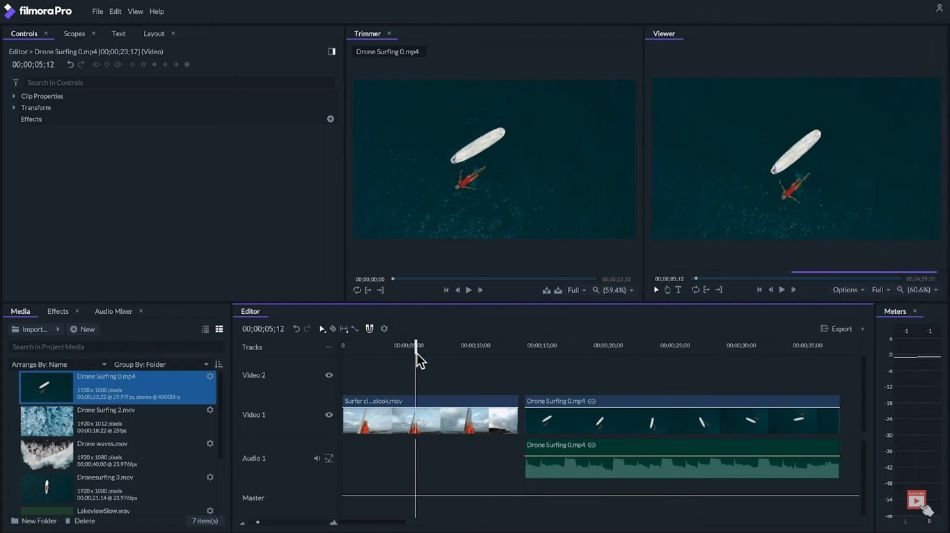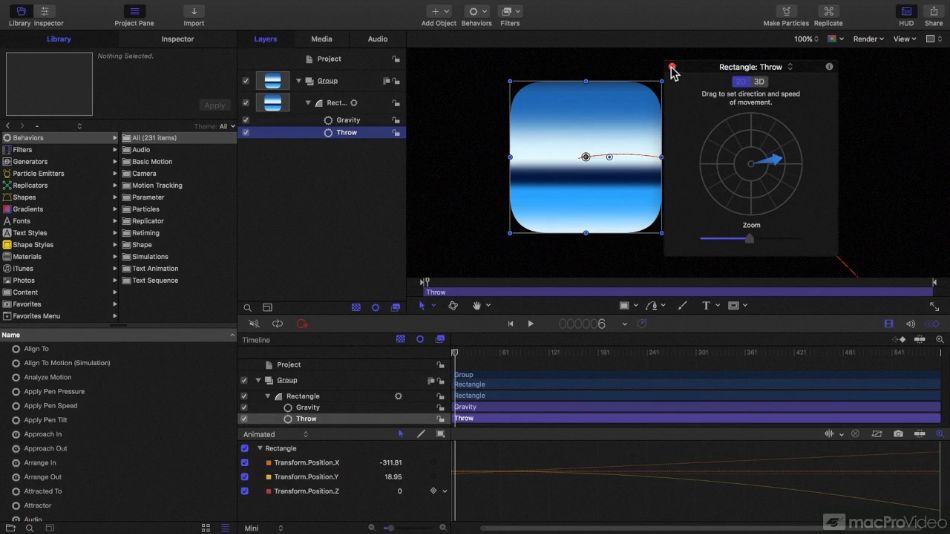program like adobe after effects
This site is reader-supported. We use affiliate links to support our expenses. Learn more
(Last updated on October 11th, 2021)
Are there any suitable alternatives to the video editing and special effects program of Adobe After Effects? Are there any that are more powerful or cheaper? Find out in this list of the best paid and free alternative applications.
After Effects has become one of the top applications regarding visual effects and motion graphics, initially developed by the Company of Science and Art in 1993. It has grown since becoming a part of Adobe and a critical program in visual effects graphics compositing.
- 1. Natron
- 2. Blackmagic Fusion
- 3. Hitfilm Pro
- 4. Blender
- 5. Filmora Pro
- 6. Nuke
- 7. Apple Motion
- Frequently Asked Questions
Having won an Academy Award for scientific and technical achievement, the application functions' extent can't be overstated. Everything from video editing to animation to green-screen background removal is possible with such a powerful piece of software.
After Effects' handy nature for all things visual comes at a bit of a price for being capable of so much. The application costs $20.99/monthly, and if you need Photoshop to fix up some materials or Premiere for editing footage, you'll be spending $52.99 for the complete Adobe Creative Suite.
That's a steep price that can add up fast. It's enough to do one search for an alternative that can do the same amount of work at a lower price. Maybe even free. Thankfully, After Effects isn't the only option for visual effects software; check out these seven alternatives.
1. Natron
Natron harbors a lot of standard features to that of After Effects but at the cost of nothing. The program is entirely free to use as it is open source and can be tinkered with your heart's content. Everything from personal VFX projects to commercial-grade work can be accomplished in Natron.
Natron embraces a node-based system that can become dense with connections but easier to organize than After Effects. You don't have to worry about the limitations of creation either, as the program allows for unlimited layers of masks, mattes, and shapes.

There are also plenty of unique tools present in Natron as well. Rotoscoping is less of a hassle with the aid of a 2D and Planar tracker. The robust keying and matte generation tools can make animation and compositing less tricky. The GPU support and network rendering functions are also top-notch.
The community behind Natron is also quite active in improving the product. Currently, there are over 250 plugins to choose from to enhance your workflow and tools better. There are also plenty of Python scripts to choose from on their website for more straightforward fixes with code alone.
Pros
- As an open-sourced program, Natron is very appealing for being completely free for commercial work and highly customizable for developers who want to tinker with the application's features and functions.
- An active community behind the program has led to plenty of plugins, tutorials, scripts, and other improvements.
- The tools spanning everything from Planar tracker to matte generation are potent and remarkable time-savers.
- The node system is perfect for a more organized workflow.
Cons
- While the program is ideal for 3D animation and compositing, it is not adept at motion graphics isn't exactly built well to handle them either.
- A slow development for the program has led to many instability issues that have made the application a struggle for some users.
- The node system will learn for those more used to the organization's After Effects interface.
Short Verdict
Natron is a solid choice for a free piece of software that can duplicate just about After Effects' functionality. The node system does take some time to learn, and there are some stability concerns, but the program succeeds at meeting most visual effects demands. It is recommended for VFX designers and compositors on a budget.
2. Blackmagic Fusion
Blackmagic Fusion's legacy has made it one of the better pieces of compositing software on the market. Capable of the same visual effects and compositing as After Effects, the application has been recognized as one of the more advanced in this field.
A slew of tools is present to make your visual effects highly customizable with such features as a node-based system and VR-based editing tools. For such a wide range of abilities, Fusion has been used in such productions as The Hunger Games, Guardians of the Galaxy, Empire, and more.

The program comes in both a paid and free version. While the paid version costs a pretty penny, you'd be surprised just how capable the program's free version is, which easily be used for creating commercial productions in 1080p without watermarks.
Pros
- Fusion has the benefit of being usable on Windows and Mac environments and Linux systems as well.
- The free version of the program is enough to create commercial-grade work without the limitations of a watermark.
- The application is one of the few out there that offers support for VR and 3D.
- The sophisticated node system makes the program ideal for scrutinizing and implementing the tiniest of solid organization details.
- Animations can automatically be retimed based on changes you make in duration.
Cons
- The one-time price of $299 for the paid version is quite expensive. You will need this version for more advanced features and render anything higher than 1080p.
- The node-based system will take a lot of getting used to if you're making the jump from After Effects.
Short Verdict
Fusion has a lot of muscle under the hood to be one of the more robust visual effects programs. The free version makes it easy to get your feet wet with industry work, and the paid version offers so much more. It is recommended for those planning to go far in the visual effects world without shelling out a lot of cash at the beginning.
Here's a detailed comparison between After Effects and Blackmagic Fusion.
3. Hitfilm Pro
For those skilled enough in all things After Effects and who want something just as powerful and elaborate, Hitfilm Pro can give you everything you need. The application includes many of the same robust features for motion tracking and sky replacement, yet you only have to pay a one-time fee of $349.
Hitfilm Pro differs in a few ways from After Effects. The editing interface works non-linearly as opposed to After Effects. What is similar to After Effects is that the program can recognize third-party plugins.

The program is quite the investment for such a hefty price upfront, but you can try it out with a free trial as well as a limited free version known as Hitfilm Express. The trial should be long enough to get used to the interface, tools, and features that are as highly competent as After Effects.
Pros
- Hitfilm Pro's upfront price is beneficial in the long run if you use it for about 15 months to match After Effects' subscription pricing.
- With over 875 visual-effects presets, Hitfilm Pro has plenty of materials to jumpstart some of the more essential VFX needs.
- The Chroma Key tool is exceptionally built to allow for the most extraordinary detail of color correction.
- The use of third-party plugins allows for plenty of expansion and improvements to tailor the application and timeline in a manner that benefits your workflow best.
Cons
- The one-time fee is quite steep and will not be as palatable for a hobbyist or someone just starting in visual effects.
- While Hitfilm is very similar to After Effects, there's going to be a bit of a learning curve trying to get used to the non-linear timeline.
Short Verdict
Hitfilm Pro is one of the more expensive visual effects applications, but you get what you pay for. And what you pay for is a pretty robust program that can accomplish everything After Effects can do and more—recommended for the more accomplished VFX artist ready for more expert-level work and willing to invest a little more for just the right tools.
4. Blender
When 3D animation software was the most expensive of applications, Blender arose as a top competitor in this market. The program was developed in 2002 to be an open-source program that went from a hobbyist tool to a serious app for creating video games, short films, YouTube videos, and feature films.
Blender is designed less like After Effects and more to compete with 3D giants Maya and 3Ds Max. It's easiest to use when conceiving 3D animation, but it can also double for crafting composited visual effects. Being open-source, it can additionally be retooled for several altercations.

Blender's usage has been rising to such a degree that it has spawned conferences and notoriety among the indie crowd of filmmakers, developers, and game creators. You can see just how effective Blender is crafting animation in the Netflix feature film NextGen.
Pros
- Blender is an open-source application and is free to use for individual or commercial use. Considering the program is capable of developing feature films, the lack of cost will be of great benefit for filmmakers on a budget.
- The success of Blender was only made possible by the numerous developers behind it, which have led to a wealth of support in the form of tutorials, forums, and plugins.
- There are plenty of tools present to refine your animations to be as intricate and detailed as possible. You can also render a completed scene with all the rendering tools with no need to bring your animation into a video editing program.
Cons
- Despite being so similar to other 3D programs, Blender is not as easy to jump into when it comes to modeling and materials. The learning curve is a bit steep when it comes to learning the software.
- Being a 3D animation program, Blender may not be as ideal for those who want to focus more on compositing than they do animation.
Short Verdict
Blender is one of the most cost-effective applications for developing 3D animation without paying a dime. It takes some time to learn and isn't as ideal for 2D work, but a lively community has helped make it all the more palatable. Recommended for 3D artists just starting in the industry and plan to get more involved with animation.
5. Filmora Pro
As a part of the Wondershare line of graphics software, Filmora Pro is not only a non-linear alternative to After Effects but also a cheaper one. The range of options for purchasing the program is vast as the tools present for editing, compositing, and motion graphics.
The interface has been built more akin to Adobe Premiere, as you can drag and drop different elements onto the timeline. This makes the program relatively easy to use for even beginners to hop right in and experiment. The handy automatic features of noise reduction and color correction also free up some workflow time.

There's a surprising amount of flexibility and power in such a program. Not only do you have the option of placing unlimited video tracks on your timeline, but your video can also be rendered at 100 frames per second and rendered at 4K resolution.
When it comes to purchasing the program, you have quite a few options. An annual subscription will run you only $89.99 a year. If you don't like subscriptions, you can simply pay a one-time fee of $149.99. There's also a free version of the program, but it's severely limited in its capabilities.
Pros
- There are numerous choices for purchasing the Filmora Pro, ranging from a one-time purchase to a subscription fee to a freemium version.
- A drag-and-drop interface makes the program more serviceable for film editors who like to have a good idea of how everything is stacked up and looking on the timeline.
- Plenty of features are present for high-quality video, whether you're aiming for a higher framerate or 4K output.
Cons
- Filmora Pro is not as ideal a program if you're seeking to produce visual effects for feature films.
- The free version can't be used for professional work as it adds a watermark to your rendered videos. You'll also have no tech support under this version, so consider this more of a free trial than freemium software.
Short Verdict
Filmora Pro is a suitable VFX application for those who find themselves somewhere between beginner and expert. It's easy enough to use, capable of high-quality renders. It is a relatively cheap application for all that it can do—recommended for those just starting to venture into commercial-grade and Hollywood level work in their VFX careers.
6. Nuke
For those seeking the top tier of visual effects programs that are not only used for Hollywood-level VFX but within a team environment, look no further than Nuke. Developed by Foundry, Nuke has become one of the most powerful compositing and visual effects applications.
The program features a node-based interface that is similar to that of Fusion. The workflow is made all the more fluid thanks to the program's power using GPU to accelerate the fastest results. The best part is that it's not taxing on your hardware that won't require the most heavy-duty machines for high-quality results.

Nuke has become widely recognized for its contributions to the VFX industry. The application has won an Academy Award for excellence. Such top studios use it as Walt Disney Animation Studios, Blizzard Entertainment, DreamWorks Animation, Industrial Light & Magic, and more.
However, Nuke doesn't come cheap. For being such an industry-standard, Nuke is one of the expensive visual effects applications. A quarterly pricing plan will run you $1,729, and a lifetime purchase will run you $4,988. For such a hefty price tag, only a lucrative studio or designer can afford such a product.
Pros
- Nuke has been optimized to be as speedy as possible without being a massive drain on your CPU while still utilizing GPU acceleration.
- The program is capable of recognizing images with opacity and color separated in layers.
- Plenty of unique camera effects can be easily added to projects, as with various lens distortion effects.
- Nukepedia offers numerous resources and helpful guides thanks to the contributions of over 37,000 artists who use Nuke.
Cons
- Nuke is a costly application to use, with both the subscription and one-time purchase plans running well over a thousand dollars.
- The learning curve is a bit steeper considering the wealth of tools and features present to master.
Short Verdict
Nuke has a lot of power behind it, but it all comes at such a hefty price. The features are incredible, and the speed at which it runs is breakneck. However, for being so spendy, this app can only be of benefit for those working on top-tier projects of video games, television, and movies. It is recommended for studios only.
7. Apple Motion
Building off Apple's success with the video editing program Final Cut Pro, Motion brings all of the essential visual effects components into the familiar and easy-to-use interface akin to Final Cut. Naturally, such a program also works in tandem with Final Cut Pro, in the same way, Adobe's After Effects can integrate with Premiere.
Also similar to Final Cut Pro is how well the program runs with great speed and power. The playback of clips is high-speed. As for rendering effects, you won't have to wait long at all as the application features real-time preview windows, avoiding the wait times of waiting for renders to finish before you can see the results.

All that being said, Motion is not as feature-heavy as that of After Effects. The areas of creating motion graphics and more advanced effects sadly lack within Motion. What's perhaps the most troubling aspect is that Motion doesn't allow for multiple timeline compositions.
In terms of what Motion can do, however, it is pretty impressive. Everything from 360-degree video editing to the simplest of title animations can be accomplished without a lot of tool tinkering to find just the right result. A host of pre-prepared animation elements also helps streamline the process just a bit more.
Pros
- Motion is also one of the cheapest of the paid After Effects alternatives for a one-time price for costing only $49.99.
- Motion is just as fast and powerful as Final Cut Pro, having been optimized specifically for Mac computers.
- The application is capable of editing 360-degree videos.
Cons
- Since Motion is an Apple product, this means the program is only available in the macOS environment.
- Motion isn't adept at handling multiple timelines, so you'll be stuck using only one for your entire project.
Short Verdict
It should be apparent based on the Apple associate, but Motion is only going to be of use to Mac users. The good news is that those who already use this operating system for editing will be pleased that the effects application works just as well—recommended for Apple users seeking a cheap and robust visual effects program for beginner-level projects.
Frequently Asked Questions
How much does adobe after effects cost?
After Effects costs $20.99 a month to use.
Can I get Adobe After Effects for free?
After Effects can be downloaded as a free trial that can be used for 7 days.
Is it worth learning after effects?
After Effects is considered an industry standard software that is absolutely worth learning if you plan on doing professional visual effects work.
Can you use After Effects without WIFI?
You need an internet connection to download After Effects but you do not need it to use the program.

Mark McPherson has been working as a video editor and content writer for over ten years. His background started in animation and video editing before shifting into the realm of web development. He also branched out into content writing for various online publications. Mark is an expert in video editing, content writing, and 2D/3D animation.
program like adobe after effects
Source: https://www.designbuckle.com/after-effects-alternatives/
Posted by: stampernernat.blogspot.com

0 Response to "program like adobe after effects"
Post a Comment